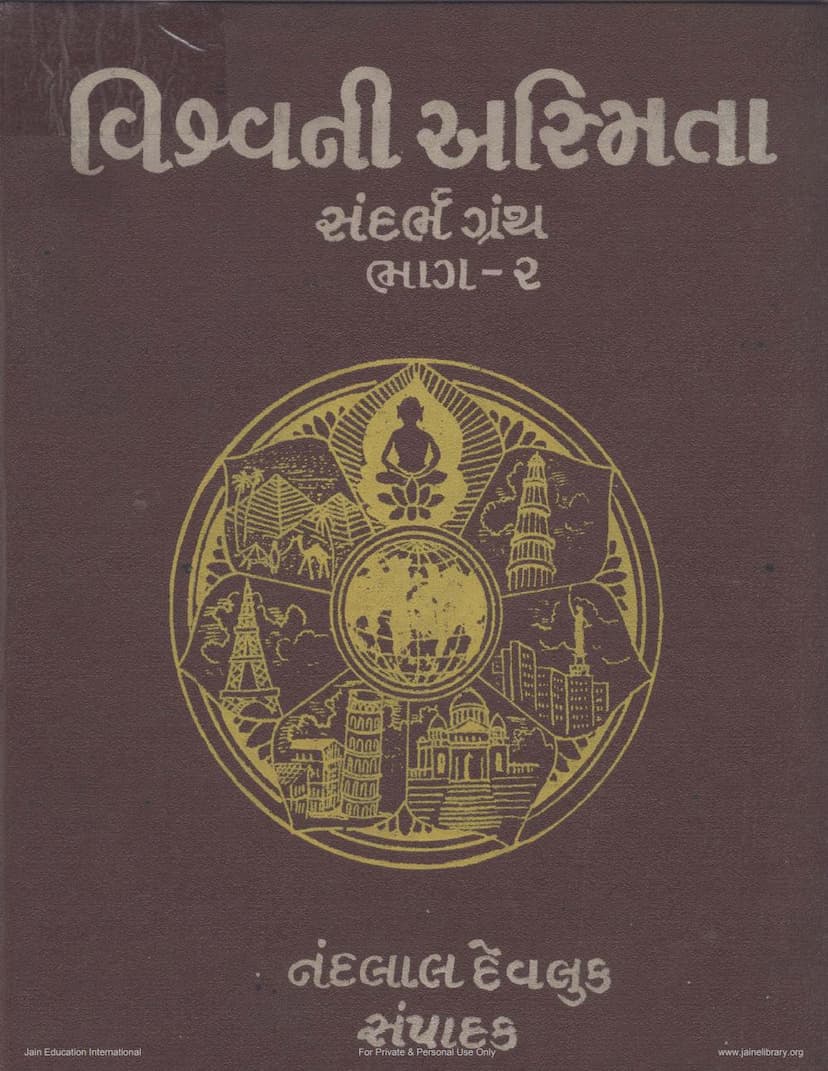Vishwani Asmita Part 02
Added to library: September 2, 2025

Summary
This is a comprehensive summary of the Jain text "Vishwani Asmita Part 02" based on the provided pages:
Book Title: Vishwani Asmita Part 02 Author: Nandlal B Devluk Publisher: Yogesh Advertising Service Bhavnagar
This book appears to be a collection of essays and articles on a wide range of topics related to global culture, history, society, science, and spirituality, with a particular emphasis on Jainism and Indian heritage. The second part of "Vishwani Asmita" offers a glimpse into the values and knowledge of our glorious heritage.
Key Themes and Content:
-
Introduction of Spiritual and Cultural Figures: The book opens by acknowledging the inspiration and blessings of Jyotirvid Acharya Shrimad VijayLabdhisurishwarji Maharajashri, highlighting his influential role in the publication and success of the reference book. His personality is described in detail, emphasizing his virtues, intellectual interests, and contributions to Jain scripture and astrology.
-
Exploration of Global and Indian Culture: A significant portion of the book is dedicated to exploring various aspects of global and Indian culture and heritage. This includes:
- Global Unity: The concept and practice of global unity are discussed.
- World Monuments: Descriptions of various ancient architectural marvels are presented, including Zigurat, the Great Wall of China, the Parthenon in Athens, the Colosseum in Rome, St. Peter's Church in Rome, the Leaning Tower of Pisa, the Porcelain Tower of Nanking, the Taj Mahal, and Ellora's Kailasa.
- Ancient Civilizations and Texts: The text touches upon ancient civilizations like the Nile river civilization and their contributions to world culture. It also references ancient texts like the Vedas and Avesta, comparing their philosophies, prominent figures, and rituals.
- Lost Fauna: A detailed discussion on the extinct animal kingdom, covering various geological eras and extinct creatures like dinosaurs, is presented.
- Societal Life and Traditions: The book delves into the societal life and unique traditions of various nations, providing brief overviews of countries in Europe, Australia, and Africa, including extensive lists of African countries.
- Politics, Sociology, and Philosophy of History: Topics like the politics of deserts, the impact of industrialization in Japan, colonialism, and imperialism are explored.
- Modern Society and Culture: The text discusses the paradox of the "Stone Age culture in the computer age," the problems of global population, and the solutions proposed.
- Global Dance Traditions: A comprehensive overview of dance traditions worldwide, including definitions, types, and specific Indian classical dances like Bharatanatyam, Kathakali, Kathak, and Manipuri, is provided.
- Marriage Customs: Various marriage customs from India and abroad are discussed.
- Global Currency: A list of various global currencies is presented.
- Final Rites: The book touches upon the diversity of final rites practiced worldwide.
- Finance and Economics: Discussions on the changing trends in global financial systems and international monetary arrangements are included.
- Women's Role and Great Women: The importance of women in India and globally, along with the lives of great women in various fields, is highlighted.
- Biodiversity: The text explores the wonders of the natural world, including animals, birds, and marine life.
- Cosmology and Astronomy: Topics like earthquakes, the origin of the universe, and the principles of astrology and astronomy are discussed.
- Literature and Spirituality: The book touches upon contemporary Hindi literature, the concept of universal humanism, the philosophy of mysticism in different religions, and the significance of Raj Yoga. It also includes essays on Gujarati novels and thinkers' views on God.
- Jainism: A significant portion of the book is dedicated to Jainism, covering:
- The twenty-four Tirthankaras.
- Agam scriptures.
- The concept of cyclical time (Kaalchakra).
- Navatattva (Nine Truths).
- Karma theory.
- The path to liberation (Moksha Marg).
- The five great vows (Pancha Mahavratas).
- Lay vows.
- Gunasthanas (stages of spiritual development).
- The Namokar Mahamantra.
- A brief overview of Digambar Jainism.
- The glorification of Shri Ghantakarna Mahavir Dev, a significant Jain deity, detailing his miracles and worship. The text highlights his special role in the current Kali Yuga and the substantial number of devotees, both Jain and non-Jain, who experience his blessings.
- The book includes extensive discussions on the principles of Jainism, its historical figures, and philosophical concepts, including Anekantavada (non-absolutism) and Syadvada (conditional predication).
- The spiritual significance of meditation and yoga is explored.
- Inspirational Figures and Organizations: The book includes write-ups on various influential figures and organizations, such as the Theosophical Society, and highlights their work and contributions.
-
Focus on Indian Heritage and Jainism: The text consistently brings the discussion back to the richness of Indian heritage and, particularly, the profound teachings and history of Jainism. It showcases Jain ideals through the lives of saints, scholars, and patrons.
-
Comprehensive and Encyclopedic Nature: The book appears to be encyclopedic in its scope, covering a vast array of subjects. The detailed table of contents suggests a structured approach to presenting diverse information.
-
Promotional and Acknowledgement Sections: Several pages include dedications, acknowledgments, and best compliments from various individuals and companies, indicating the collaborative nature of the publication and the support it received. Notably, the text mentions the contribution of Yogesh Advertising Service Bhavnagar and individuals associated with its publication.
In essence, "Vishwani Asmita Part 02" seems to be a valuable resource for understanding the breadth of human knowledge and culture, with a strong emphasis on the enduring spiritual, philosophical, and societal contributions of Jainism and India.